Hello Mixed-Up Filers!
I’m incredibly excited about today’s interview! This year, it’s been a real treat to get to speak to some great pop culture icons, and this is no exception. Today, we have a music legend. Besides being a lifelong fan of our guest’s music, I absolutely love Bye Bye Birdie, which has some of the catchiest songs of any musical. So, please help me welcome Bobby Rydell!

JR: First off, thank you for agreeing to do the interview, and I’ll try not to gush too much while doing it. I’m a big fan of yours, and could probably listen to I’ll Never Dance Again on an all-day loop.
BR: Thank you, that was a good record.
JR: I was reading your book, Bobby Rydell: Teen Idol on the Rocks: A Tale of Second Chances, and was amazed at how young you started. You won a talent competition at the age of ten and became a regular on TV, The Paul Whiteman Show? What was that experience like for a kid your age?
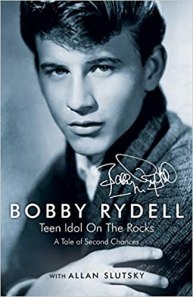
BR: Well, it was a talent show in Philadelphia. WABC TV, channel 6 in Philadelphia, and they had this talent show, where they gave a chance for young kids to get a break. But the funny thing about it, was that it was Paul Whiteman, and that was his show. and the piano player for Mr. Whiteman was Bernie Lowe. And I’m ten years old. And at sixteen, when I sign with Cameo Records, Bernie Lowe was the president of Cameo, which later became Cameo Parkway. So, I had a relationship with Bernie, when I was ten years-old.
JR: That’s amazing.

BR: Yeah, it’s a great story. So I won a part on the show, and became a regular on the show, and the sponsor was Tootsie Roll, and I think I have some Tootsie Rolls left from when I was ten years-old. I don’t know how many Tootsie Rolls I got. I also won an RCA 45 record player, and an RCA 10-inch TV.

JR: That’s incredible. Your parents were very supportive, in particular your dad. Do you remember it being something that you wanted to do or did you feel pushed into it.
BR: No, I was never pushed into anything. If I had any talent whatsoever, my father was the first one to see it. Because I used to mimic everyone I saw on TV, and I started singing at a very early age. And when I was around seven or eight years-old, my father started taking me around to nightclubs, and he would ask the club owners, “Is it okay for my son to get up, sing a couple of songs, and do some impersonations?” So, I’m seven/eight years old, I get up on stage, sing a couple of songs, and people applauded. So, I say, “Wow! All I have to do is do this, and they do that?” What a wonderful feeling. So, basically, that early part of my life was like my Vaudeville, and it kind of got me ready for things that were going to happen later on in life.
JR: Now, getting back, you’re a regular on a TV show at the age of ten. Were you aware of how different that was from what other kids were doing? Or was that just what you thought was the normal thing to do?
BR: Good question. You know what? All of the guys and girls around the neighborhood, I used to do this stuff in front of them. Just hanging around the street corner or the steps. I would do impersonations or sing some songs, and they all loved it. Then, when I became a television star at ten years-old, I became really popular in the neighborhood. There were so many talented people that came out of my area in South Philadelphia. I mean, you could go back to Mario Lanza, Al Martino, Buddy Greco, Eddie Fisher, Joey Bishop. Then guys like me, and Frankie Avalon, Fabian, James Darren. We all lived like within ten blocks of one another.
JR: That was some neighborhood.
BR: Fabian and I were born on 11th Street, and Frankie on 9th Street, and Jimmy Darren was on 10th Street. And they’re all great guys, they really are.
JR: You prefaced my next question about growing up in Philadelphia, which was a hot spot for music. Also, you had a childhood friendship with Frankie Avalon, and he, in a roundabout way, helped your career kick off. Can you tell me a little bit about that?
BR: He didn’t really help kick my career off. When I was ten, Frankie was twelve. And I played drums, and did imitations, and sang, and Frankie played trumpet, and we used to go around and did shows for Veterans Hospitals and senior homes, and musically, Frankie would play trumpet, and I’d play drums. We knew each other from the time I was ten years old. And I remember Frankie saying after he’d made it, which was somewhere around the ’56 or ’57, and he said, “The only other guy who’s going to make it coming out of the south Philadelphia area is Bobby Rydell.”
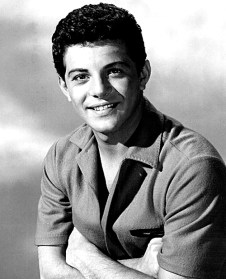
BR: Now we do a show, I’m sure you’re aware of it, called, The Golden Boys, and we started that show in 1985, and it was a tremendous success. And I said to Frankie, and I called him Cheech, because in Italian, Frank is Cheech. I said, Cheech, this is great, but how long is this going to last? A year, two years tops, it’s over.” Well, that was in 1985, and we’re going on 2021, and we’re still doing the show. It’s amazing.
JR: I read that you’re tentatively scheduled to be around my neck of the woods next year, I hope so.
BR: Where’s your neck of the woods?
JR: South Florida.
BR: Yeah, hopefully we’re going to be there. You know with this Covid thing, we really don’t know what’s going to be. I think the last show that I did was somewhere around March 14th, and everything that was on schedule after that was either cancelled or postponed. So, we’re still up in the air and don’t know what’s going to happen. Hopefully, things start opening up pretty soon.
JR: Well, if you get down to south Florida, dinner’s on me.
BR: Good, you know any good Italian restaurants?
JR: There are actually. There are several. Lots of New Yorkers down here, and people from the Northeast.
BR: There you go!
JR: At seventeen, you appeared on maybe the biggest music program in the country, American Bandstand with Dick Clark for your song Kissin’ Time. Can you tell us about what Dick Clark was like, what that meant for your career, and everything that you were going through at the time?
BR: I remember when I first signed with Cameo, I had three recordings prior to Kissin’ Time. And Bernie Lowe used to take the acetates over to Dick Clark, and Dick had turned down the three songs. And the fourth song was a song called Kissin’ Time, and he took the acetate over to Dick, and Dick dropped the needle on the record and Dick said, “That’s a hit!” And then, I appeared on American Bandstand. And it started at 3:30 in the afternoon until 5:00 in the afternoon, across the country. So, immediately when Dick played a record on American Bandstand, all the kids across the United States were going, “Wow, if Dick was playing this, we have to go out and buy it.” So, he was an integral part of my career. He was a wonderful, wonderful guy. Really a sweetheart of a man. And our friendship went back to 1959.
When he had his big shows, the anniversary shows when he was in California, he was a perfectionist. An absolute perfectionist. He had to know where this was, why we were doing that. He really knew what was happening. Like I said, a sweetheart of a man.
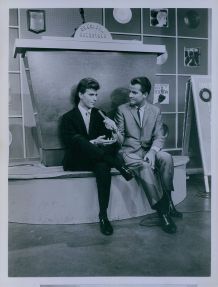
JR: So what you saw on screen was the real person.
BR: Absolutely.
JR: At around 18/19 you had a couple of million sellers, you also released what’s probably your signature song, Volare, and then you headline the Copa. That’s mind-boggling. What was going through your mind during this time? Were you nervous? Confident? What?
BR: Well, I had two wonderful people. I had a guy by the name of Lou Spencer, who was one of the original dancers in a team called the Dunhills. And they used to open for Danny Kaye. So. Lou Spencer was in the business for quite a few years. And then the man who wrote my special material, was a man by the name of Noel Sherman, who wrote for Nat King Cole. He wrote a special piece of business for Nat King Cole called, Mr. Cole won’t Rock-N-Roll. He wrote a special piece of material for Paul Anka, and a special piece of material for me, called, They Don’t Write ‘em Like That Anymore.
Of course, prior to the Copa, we went to The Holiday House in Pittsburgh, The Three Rivers Inn in Syracuse, just to fine tune the act prior to getting it to New York City, and opening at the Copacabana. And Lou Spencer, he was a funny man, he used to carry a roll of toilet paper with him, and after the show, we would sit in the hotel room, and he tore off a little piece of toilet paper and said, “This is everything you did right.” And then he would roll out the toilet paper and say, “And this is everything you did wrong.” So, I worked hard. I really, really worked hard, so when we finally did get to the Copa, the act was absolutely fine-tuned. But, I remember when they introduced me, “Ladies and gentlemen, the Copacabana proudly presents the star of our show, Bobby Rydell!” and all of the captains, the red coats, the white coats, the blue coats, they’re hitting me on the shoulder, “Knock ‘em dead, Bobby!”
And my opening song was, Lots of Livin’, and my mom and dad were in the audience, and the band is playing with a great orchestra, and the first four to eight bars I was shaky, and my father almost had a heart attack, but after that, I settled down, and everything was great after that.
JR: Just incredible. I can’t even imagine. Frank Sinatra showed you a lot of respect when you met, and said he was an admirer of yours. What was your relationship with him like?
BR: Well, one night, my dad and my manager, who was Frankie Day, were at the Copa to see Joe E. Lewis, the old comedian that Mr. Sinatra made a movie about, called the Joker is Wild, about Joe E. Lewis’s life. So, one night, I was doing German TV, and I was going to meet my dad and my manager. And I walk into the club, and one of the waiters, Carmine, he said to me, “Bobby, Frank is in the room.” I said, “I know.” Because I thought he was talking about my manager.
He said, “No, Bobby. Frank.” And my jaw dropped. And he said, “You want to sit with him?”
I said, “Oh my God, no.” I’m nineteen-years-old. Anyway, after the show, Sinatra leaves, and I thought, that’s it. Because, I really have admired him since I was ten years old. And we go upstairs to say goodnight to Jules Podell, who was the boss of the Copa, and through the kitchen doors, comes Sinatra. And I say, “Uncle Julie,” I called him, Uncle Julie, and I say, “Uncle Julie, all I want to do is shake his hand. And Julie says (in a gruff voice), “You wanna meet Frank?”
So, Sinatra is sitting at the table with two marvelous lyricists/songwriters, Sammy Cahn and Jimmy Van Heusen, Richard Conti, Joe DiMaggio.
JR: Wow!
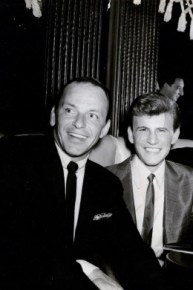
BR: So, Podell taps Sinatra on the shoulder and says, “Frank, I want you to meet the kid.” And Sinatra stood up, looked at me with those blue eyes, stuck out his hand, and said, “How you doing, Robert?” He called me Robert.
I said, “I’m fine, Mr. Sinatra, how are you?”
“Wonderful, would you care to join us?”
“It would be my pleasure, Mr. Sinatra.” I sat there and couldn’t say two words, I was in awe.
Sinatra turns to me and says, “What do you drink, Robert?”
I said, “C-coke.” I figured if I would’ve said Scotch and water, I would’ve got a smack in the face. But, he was absolutely wonderful. I have pictures with him, where under his arm, he has my album, Rydell at the Copa, and his other arm is around my shoulder. And on the album, he wrote, To Bobby, all the best, your friend, Frank Sinatra. And I had been in his company quite a few times after that, and he was always marvelous.
JR: Right now, I’m in awe. Let’s transition to Bye Bye Birdie. You’re still in your teens, and come up for the part of Hugo Peabody. I read that one of the people you were up against was Bobby Vinton, and that was one of the things that motivated you. Not wanting to lose the part to someone else.
BR: I never really thought that. I knew Bobby, of course. You know, I remember when we used to work, it was the Brooklyn Paramount, or whatever, and Bobby Vinton had the band. Before he recorded, he was a saxophone player, and he had the band to back up all the acts in the show. From what I understand, he screen-tested for the part, and then when I went out to California, and I screen-tested with Ann Margaret, and George Sidney, who was the director. We read some lines from the script, talked into the camera. They wanted to see what kind of personality we had, how you came across onscreen, so on and so forth. We sang a couple of lines from One Boy, then, “Thank you, we’ll be in touch.”
So, I go home to Philadelphia, two weeks go by, and then my manager, Frankie Day, calls and says, “They want you for the part of Hugo Peabody.” Wow. So, I go see the play, and I’m looking at Hugo Peabody, and he doesn’t sing, there are no lines, there’s no dancing, he just stood there. But, when I go out to start filming, Mr. Sidney saw some kind of magic between Ann Margaret and myself, and every day that I went back to Columbia Studios, my script got bigger, and bigger, and bigger. More dialogue, more singing, more dancing. And I’m not a movie star by any stretch of the imagination, but if I had to be in one picture, it’s a classic, such as Grease. And I’m really happy to be involved with something that was that wonderful.

JR: Well, adding more and more, as this part grew and grew and grew. Did that put more pressure on you or make you more confident because they wanted you in it more?
BR: Well, the big dance number in Bye Bye Birdie, the A Lot of Livin’ To Do number. I was never a dancer. And by that, I mean, I never laid down taps. I wasn’t a soft shoe type of guy, but I was always a fairly good mover, and everything in Bye Bye Birdie is all moves. The shoulders, the legs. And Onna White, who was the choreographer. It took two weeks to rehearse that, and another two weeks to shoot it. It was a very, very intense number, with all these different camera angles, and close-ups. And Onna White broke her leg, and she was on crutches, teaching us. But, thank God she had an assistant, and his name was Tommy Panko. And he took over the majority of the work, since Onna White was on crutches.

JR: So, you win this part in Bye Bye Birdie, a major musical, and even though you had been on TV, and were a huge rock star in your own right, were you at all nervous to be in a movie with such established stars such as Janet Leigh, Dick Van Dyke, Maureen Stapleton, Ann Margaret, Paul Lynde, Jesse Pearson, and directed by an accomplished director, George Sidney.
BR: Of course. I was awestruck. Dick Van Dyke, he was just marvelous. Janet Leigh, so many motion pictures, and what came to my mind, was, of course, Psycho. Paul Lynde, what can you say? Maureen Stapleton, it was just a great cast. No quarrels, no spats. Nobody had a big head. It was a good environment. And I think it took somewhere between three to four months, maybe a little bit more to put everything together.
JR: I’m going to do a roll call the actors and your remembrances of them, and any anecdotes you can share with us.
BR: George Sidney – He was great. As a matter of fact, years after, when I was working Vegas, he came in to see my show, and I was dumbfounded. And he had studio 8×10’s of Ann, and me, and him, and he’s showing me, and he says, “You’re probably thinking, what the hell does he want me to do now?” But he was a wonderful, wonderful man. Great director. Besides Bye Bye Birdie, he did so many wonderful movies.

Ann Margaret – Ann, to this day, we still talk. We’ve been friends since 1963. And, when I call her, or she calls me, I say, “Hi Kim,” and she’ll say, “Hello, Mr. Ridarelli.”, which is my real name. I think the last time we spoke was when Roger Smith passed away, her husband. I called her up, I gave her my condolences. And she said, “Thank you so much, but you remember how sick he was.” I said, “I certainly do, but I just want to express my condolences.” But, she is a sweetheart. A wonderful person.

Janet Leigh – I didn’t spend that much time with Janet Leigh. They were all nice, they were all wonderful people, but I really didn’t have much to do with Janet.
Dick Van Dyke – We had a couple of little pieces in the movie. Paul Lynde, of course was the father, Mr. MacAfee, and he was brilliant. And Maureen Stapleton, what can I say? The most I really spent with anyone was with Ann Margaret, because in the film, we were boyfriend and girlfriend.

JR: Are there any other anecdotes you can share with us about the making of the film?
BR: I think there’s a scene where Conrad Birdie, Jesse Pearson, was rehearsing in the high school gym, and I’m walking around the top of the gym, and I see him kiss Ann, and she faints. And I jump down from the balcony to the basketball court. And I’m holding Ann, since she’s fainted. And, if you really, really look closely at that particular scene, you can see the two of us just starting to laugh together at one another.
JR: I’ve seen that movie so many times, and never noticed. I’m going to have to watch again. At the time, did you get the sense that the film would have staying power?
BR: I didn’t even know what record I recorded would be a hit. I went in and did it and got very lucky in my recording career. And the movie, it was a hit Broadway show. And to be a part of that movie, of course you have to think this is going to be a monster movie, which it was.
JR: How often do you go back and watch it and does anything strike you when you do?
BR: Not really, but I get so many emails from fans. My wife is originally from Scranton, and we have a summer home in a place called Lake Winola. So, we’re watching TV, and flipping through channels, and all of a sudden, Bye Bye Birdie. And I don’t know if my wife ever watched the whole movie, but we left it on, and she says, “Oh my God, look at you. What happened?” (Laughs) Every once in a while when it’s on, I’ll give it a glimpse.
JR: I just showed it to my kids for the first time, this week.
BR: Did they like it?
JR: They did, and my daughter had a question. Did Harvey Johnson ever get a date for the prom?
BR: (Laughs and sings Harvey Johnson part in Telephone Hour) I don’t know.

JR: Later on, you appeared in the play, but this time as Albert. Was it surreal for you to revisit it from a different perspective?
BR: I forget who my manager was at the time, and he asked me if I’d like to do Summer Stock. I said, I love Summer Stock. The first Summer Stock I ever did was West Side Story in Columbus, Ohio. I said, “What’s the part?” He says, “Hugo Peabody.” I said, “I’m forty-five years old. Fuhgeddaboudit.” And in the Broadway show, Hugo Peabody doesn’t do anything. Two days go by, and he says, how about Albert Peterson, the Dick Van Dyke role? And I think, now you’re talking. I don’t remember the cast, but the girl who played Rosie was really, really good. And we did a lot of the things that were portrayed in the movie, and I got to do, Put on a Happy Face, and Everything is Rosie. So, it was a great experience for me. I truly enjoyed doing it. I think it was a week in Boston, a week outside of Philadelphia, and a week in Atlantic City. It was a lot of fun.
JR: Moving on, the musical Grease comes along, and names the school in the play after you, Rydell High. Was that something that they told you about beforehand, or were you surprised?
BR: I was surprised. My dear friend, Frankie, was in the movie and played Teen Angel. On the show we do, Golden Boys, he does the tune. He does, Beauty School Dropout. I just heard, there’s a movie out called Grease, and the school is Rydell High. Everybody asked why, and I don’t know. Could’ve been Fabian High, Presley High, Everly High, Anka High, and they picked me. They picked Rydell.

JR: I think that’s great. What’d you think about the portrayal of you by Von Lewis in Green Book?
BR: You know, I met him, and what a sweetheart of a guy. The only thing, when they showed the beginning of the movie, people are walking into the Copa, and the guy says, Bobby Rydell, I knew him when he grew up a snot-nosed kid in the neighborhood. Nobody knew him, and the other guy says, well, they know him now. And I think Von Lewis did a helluva job on it. Vocally, he did a great job on Old Black Magic. And when I do my show now, I have that film clip of people coming into the Copa, the little pieces of dialogue, and then the, “Hi, I’m Bobby Rydell.” And then I show the film clip and it goes into applause, and I say, “You hear that song he sang? That was one of my hit records back in 1960/1961, and the band is vamping in the back as I’m talking. And I say, “I’d like to do that one for you now, live.”, so, it’s pretty cool. So, Von was a sweetheart. A real nice guy.”

JR: Yeah, I thought it was a very good portrayal.
BR: The only thing was, why did they put him in that outfit whatever it was? I never wore that. It was always a black tuxedo. When you worked nightclubs, it was always a black tuxedo, so I couldn’t understand why they put him in that. (Laughs)
JR: You still tour both solo and with Frankie Avalon and Fabian, as part of The Golden Boys. How is that, getting to work with your friends?
BR: You know, it’s great. My manager at the time was Dick Fox, who had the bright idea to put three Italian kids together. Teen idols and do a show. And I talked to Frank, Frank talked to Fabian, Fabian talked to me. And we all said, that sounds great. And one of the lines Frankie says onstage is, “Look at the three of us. Three guys who hung out on the corner in South Philadelphia, and now, we’re hanging out onstage together. And the friendship is there, there’s no animosity. I mean, since 1985, and we’re going into 2021 and still doing it, we’re having a ball doing this.
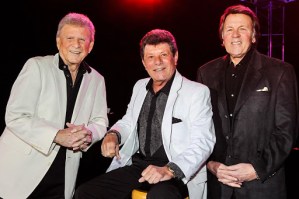
JR: How often do your fans reach out to you?
BR: Well, you know what? I had moved from my original house. We were in an area called Penn Valley, which was a suburb of Philadelphia in which is what they call the Main Line. And my first wife passed away, and my mom and dad, and I remarried Linda. And now, it’s Linda, me, a cat, and a dog, and 5,000 square feet. So, I said, we gotta get out of here. So, we found this house in a beautiful, beautiful area. Around fourteen miles from where we originally lived. And, for some reason, and I don’t know why, I get tons and tons of mail. Every day! I mean, I used to get mail at my old house, but this is ridiculous. I don’t even know how they found out where I’m living now. To sign pictures, records, hats. You name it, they send it. But I sign everything and we send it back to them.
JR: That’s very funny, and it shows how much devotion your fans show. I always ask, what was your favorite childhood book?
BR: I was never a reader, but years ago, I used to read all the Alfred Hitchcock, the pocket books.

JR: Since Bye Bye Birdie is a favorite of so many people, what’s your favorite movie?
BR: I have to go back. And I don’t care how many times it’s on, I was a big fan of Humphrey Bogart. Love Bogart. So any time Treasure of the Sierra Madre comes on . . . I don’t care. I gotta watch it from start to finish. I gotta watch Casablanca. I gotta watch The Maltese Falcon. There are certain lines I love in The Treasure of the Sierra Madre, which I’m sure you know, with Alfonso Bedoya, “Badges? We don’t need no stinkin’ badges.”
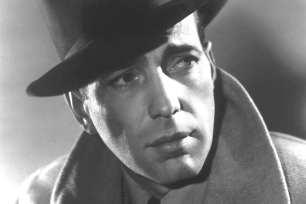
JR: How can people follow you on social media?
BR:
Website: www.Bobbyrydell.com
Facebook Official Bobby Rydell
Twitter: @BobbyRydell
Instagram: @OfficialBobbyRydell
To purchase an autographed copy of Bobby Rydell’s book: http://www.bobbyrydell.com/bobby-rydell-teen-idol-rocks/
JR: Mr. Rydell, I thank you again for doing this, it was a real pleasure to get to speak with you.
BR: It was my pleasure.
JR: Well, that’s it for this time, Mixed-Up Filers! Hope you enjoyed reading.
Until next time . . .
Jonathan
Like this:
Like Loading...
 You once told me that your brand has become “brave girls in danger (and spying!)” and that’s so true! What draws you to writing historical MG fiction and especially these types of stories with spying and brave girls?
You once told me that your brand has become “brave girls in danger (and spying!)” and that’s so true! What draws you to writing historical MG fiction and especially these types of stories with spying and brave girls? came from the amazing discovery that my ancestors owned the house and barn that were used as the American headquarters on the Saratoga battlefield during the Revolutionary War. That fact is especially remarkable because I’m originally from Michigan and moved to the Saratoga area before I knew of my family history! When I walked that land, I wondered what it would be like to be a twelve-year-old girl living in that house, and a story was born.
came from the amazing discovery that my ancestors owned the house and barn that were used as the American headquarters on the Saratoga battlefield during the Revolutionary War. That fact is especially remarkable because I’m originally from Michigan and moved to the Saratoga area before I knew of my family history! When I walked that land, I wondered what it would be like to be a twelve-year-old girl living in that house, and a story was born. SKYLARK AND WALLCREEPER, your debut novel, was published in 2018 through Little Bee Book’s Yellow Jacket imprint. For your next two novels, you chose to self-publish. Could you tell us about that decision and the differences between the two?
SKYLARK AND WALLCREEPER, your debut novel, was published in 2018 through Little Bee Book’s Yellow Jacket imprint. For your next two novels, you chose to self-publish. Could you tell us about that decision and the differences between the two?





















 🎒
🎒
 Series, The Caged Graves, and We Hear the Dead. Her seventh book, Jadie in Five Dimensions, will release in the fall of 2021. Dianne was a public school teacher for 25 years before leaving the profession to spend more time hanging around creepy cemeteries and climbing 2000 year-old pyramids in the name of book research.
Series, The Caged Graves, and We Hear the Dead. Her seventh book, Jadie in Five Dimensions, will release in the fall of 2021. Dianne was a public school teacher for 25 years before leaving the profession to spend more time hanging around creepy cemeteries and climbing 2000 year-old pyramids in the name of book research.